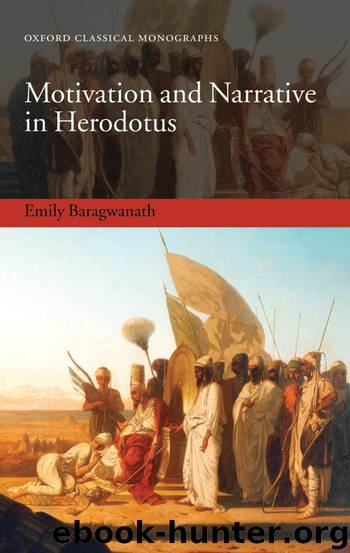Motivation and Narrative in Herodotus by Baragwanath Emily;

Author:Baragwanath, Emily;
Language: eng
Format: epub
Publisher: Oxford University Press, Incorporated
Published: 2008-03-14T16:00:00+00:00
8
Xerxes: motivation and explanation (Books VII–IX)
A study of Herodotus’ presentation of Xerxes illuminates some of the ways in which motives ascribed to actors in the Histories interact, often to a specific powerful effect, with wider patterns of explanation. One important function is to aid the text’s latent structures to surface from time to time. Herodotus’ conjectures of alternative possible motives, for example, to take the most striking instance, at times appear to encapsulate in more vivid form the rival explanatory paradigms the text offers for Xerxes’ behaviour. Thus they sharpen readers’ awareness and active evaluation of those paradigms. Indeed, I shall argue that these statements of double unresolved motives mirror the broadly bipartite character of the Histories’ underlying explanations regarding Xerxes. In other cases, the explanatory paradigms are themselves effective enough in guiding readers to reflect upon questions of motivation, and so they replace specific ascriptions of motives.
We have observed how Herodotus’ text tends to favour structural/explanatory schemata characterized by polarity,1 in part no doubt because of the particular heuristic value of these. Hartog has formulated the ‘rule of the excluded middle’: the way in which Herodotus inverts the Persian ‘Other’ versus Greek opposition, for example, when he comes to deal with Amazons, enables readers to grasp the nature of the Amazons’ even more extreme otherness.2 These polarities are not stable (and this is an aspect Hartog’s study played down3); they are there to be undermined or qualified; but they nonetheless add intelligibility by offering readers a structure to work from and think with.4 The discrepancies that emerge between general schema and particular instances5 draw readers to question the extent to which the polarized schema is accurate, and to modify their conclusions accordingly. Alternatively, a single individual or situation may at times be the focus of polarized, or at least contrasted, frameworks of explanation. In this case readers are drawn into beginning a process of weighing up the alternatives. The question in their minds becomes ‘which of the two’ explanatory paradigms is the more convincing or useful to think with, as we shall see in the case of Xerxes. As with statements of double unresolved motives, such paring down of options to ‘either-or’ possibilities seems part of a strategy intended not only to simplify and thus add intelligibility, but also to engage readers all the more actively in the process of evaluation.
The attributions of motives in the Xerxes’ narrative (particularly again the attributions of alternative possible motives) may alert readers also to the contrasting perspectives—Greek and Persian—that underlie the wider explanations. In this respect their function parallels that of Herodotus’ double source citations, which likewise keep readers attuned to the way in which informants’ perspectives influence the stories they tell. The motive statements do so more subtly, in a fashion better suited, perhaps, to the extensive narrative sequence. Readers frequently are tempted to assume that the contrasting suggestions of motivation do derive literally from different sources.6 Such ascriptions of motives thus raise readers’ awareness of the nature of the decision
Download
This site does not store any files on its server. We only index and link to content provided by other sites. Please contact the content providers to delete copyright contents if any and email us, we'll remove relevant links or contents immediately.
Letters From a Stoic by Seneca(2333)
The Valmiki Ramayana: Vol. 1 by Bibek Debroy(2173)
The Valmiki Ramayana: Vol. 2 by Bibek Debroy(2034)
The Valmiki Ramayana: Vol. 3 by Bibek Debroy(1856)
Mary Boleyn by Alison Weir(1461)
The Greeks by H. D. F. Kitto(1431)
The Notebooks of Leonardo Da Vinci by Da Vinci Leonardo(1249)
Art of Living by Sellars John;(1175)
Mythos (2019 Re-Issue) by Stephen Fry(1169)
The Voynich Manuscript by Gerry Kennedy(1163)
Annals by Tacitus(1158)
Medea and Other Plays by Euripides(1150)
The Classics by Mary Beard(1085)
Claudius the God by Robert Graves(1038)
Kadambari: Bana by Bana(1005)
Appeasement of Radhika by Muddupalani(1000)
Atlantis the Lost Continent Finally Found by Arysio Santos(997)
THE REPUBLIC by plato(992)
Beyond Control by Anthology(979)
